Prague’s revolution revival: massive bees, cartoon dogs and a sense of hope
The sky above the Vyšehrad castle turns gold, the night slowly creeps into the picturesque cobbled streets and the tucked away corner close to the Vltava river is humming with final preparations. Young artists are trying to navigate through a mess of brushes, paint cans, old newspapers and artificial flowers to finish their masks, sculptures and a floating bee model, the centrepiece and theme of the carnival parade. It feels surreal; everyone is patiently gluing, painting and attaching fairy lights. Jakub Otčenášek, a spokesperson for the Velvet Carnival, defined the movement as “an intersection between protests, celebrations, entertainment and something to reflect on.” It is a satirical step out of normality.
Barbora Nováková sits on the dusty floor of the warehouse, writing the word ‘handicap’ on an old Victorian pushchair painted in gentle pastel colours. Tomorrow, Barbora will be selling a chewing gum, which guarantees to hide you from all the problems in your own social bubble. ‘Blow your own bubble!’ is the second group in a parade of 13 movements participating in the Velvet Carnival. They all aim to comment on current political and social issues with satire and loud music. It will be provocative for sure – traditional commemorations are a serious and noble event. But tonight, they will participate in a small and unannounced parade ‘Charivari’ across Prague, enjoying the stunning views, darkness, lanterns and drink beer as they walk along the river. It is a strange communal feeling to see a massive bee crossing a street, a young student dressed as a deer dancing in the rhythm of drums and a group of gigantic skulls forcing cars to stop with a wheel of fortune.
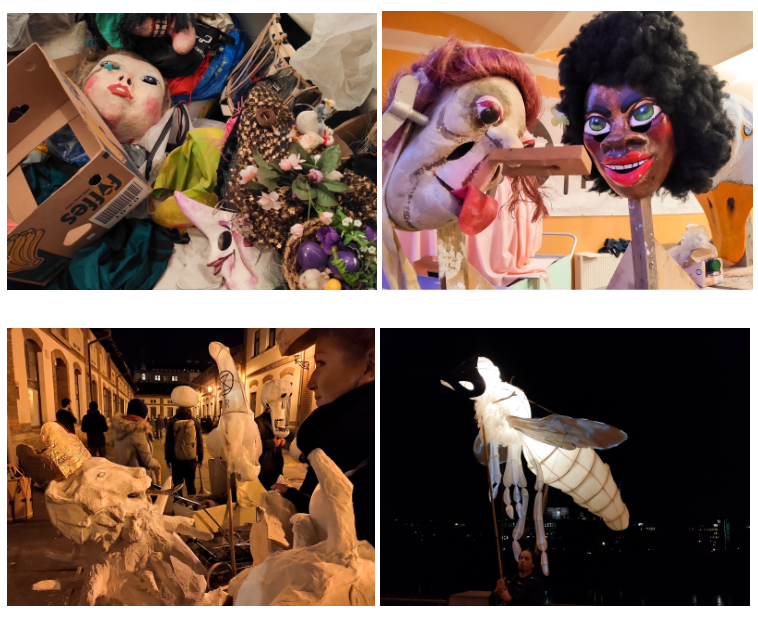
The Velvet Carnival celebrates the 30th anniversary of the Velvet Revolution, the reason why I flew to Prague for the weekend. On the 17th of November 1989 students took to the streets to remember the closure of Czech universities in 1939. Nazis stormed the Charles University, killing nine and sending over a thousand students to concentration camps. The commemorative event 40 years later turned into a demonstration against communism and was violently suppressed by the state police on the National Avenue in the centre of Prague. The brutal attack on peaceful students marked the beginning of the rapid and non-violent Velvet Revolution. On the 28th of November 1989 the communist regime came to an end. The following month the parliament elected the dissident and playwright, Václav Havel, as president.
As I walk the streets of Prague, it all seems jolly. Czech flags are decorating the baroque houses, I can see flyers celebrating 30 years of freedom on every corner and people wear pins with Havel’s face. But underneath all the pride and three-coloured badges, it is obvious that Prague is unwell. The city is divided between the pro-West young generation and melancholic citizens nostalgically dreaming of communism. A nation-wide survey by NMS Market Research showed that 38% of over-40-year-olds think their lives were better under communism. Some miss the stability and order; others sentimentally recall queues for bananas and oranges. The generational polarization is a nationwide phenomenon. While youngsters protest, elderlies fall for cheap populism and radical nationalism.
Today is Saturday, the day of demonstration organized by civil group Million Moments for Democracy. This NGO managed to gather over 250,000 people in an anti-government rally in June. It is a warm sunny afternoon and the Letná Park is slowly filling up. Czech and European flags are flying high alongside homemade banners, creatively criticizing Prime Minister Andrej Babiš. They come here to demand the PM’s resignation, due to his conflict of interest and alleged corruption. For many he is a threat to the young democracy. I walk through the muddy field surprised at the number of pensioners rallying in support of the young students, who once again lead the protest. The chairman, Mikuláš Minář, gets on the stage holding his old school folder with a picture of Maxipes Fík, a famous cartoon character of a giant – but friendly – dog printed on the front. It feels like the revolution is revived, the crowd cheers as a video projection plays the scenes from the 17th of November 1989 with chants ‘Long live Havel. Long live the truth!’
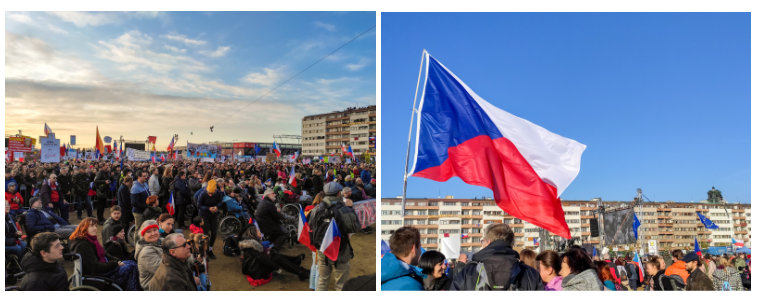
However, implementing Minář’s vision will be difficult. The resignation is not on the PM’s agenda and his party, Ano (Yes), received nearly 30% of votes in the parliamentary elections in 2017. In the meantime, the oppositional parties are busy fighting each other. Markéta Adamová, the leader of the oppositional party Top09, praised people participating in the demonstration but said there’s “little chance” to unite the opposition or change the electoral system.
Petr Houdek is not satisfied with the political representation either. He sits next to a row of tractors, which Czech farmers drove to Letná, writing his opinion on a wooden board. “It bothers me who is leading this country and in which direction we are heading. I don’t want to be a pessimist, but I’ve already chosen a country to move to,” passionately explains Petr, “we have forgotten this land is ours and that we are the state.”
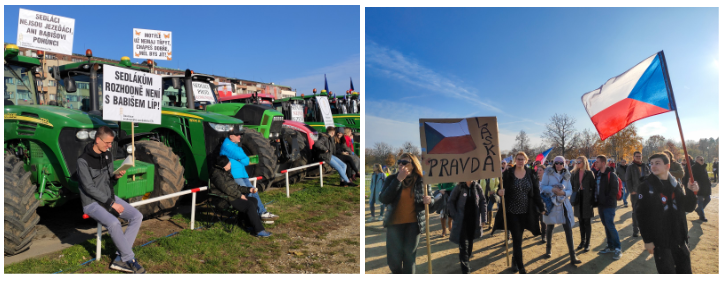
The PM is not the only one condemned. Miloš Zeman, who is serving the second term as President, is a common target of criticism. Being a pro-Russian political dinosaur, who promised to keep the PM in power, does not help him in charming young voters. They are attracted to a European vision of open borders, freedom of expression and Havel’s ideals of love and truthfulness. Where socialism and left-wing parties win young hearts in Western Europe, here they support right-wing liberals with pro-EU stances and progressive approaches to economy and climate change. Ondřej Dehner, a student from an eastern city of Opava, shares with me his struggles with the generational disillusion. “My grandmother is a communist,” he openly admits, “I’m trying to communicate with her. She is a kind and loving person but on the other hand she still believes in the communist ideals.” The Communist party is now a key ally of the PM, keeping the Ano party in power. Ondřej blames old generation’s conservatism for their election success. “I think my grandmother does not understand that communism has never really worked,” he says.
On Sunday morning the atmosphere is still rebellious. Many have new pins with the Czech flag, right next to badges supporting Million Moments for Democracy. I meet the PM while crossing the street next to the National Museum. I later learnt when he was laying wreaths at the memorial at the National Avenue, the crowd booed. During the day I witness many similar accounts. People clap when oppositional members light up candles and boo as soon as communists, nationalists or coalition partners appear. The division in the Czech society cannot be clearer.
As the day goes on, I see more candles, flowers and three-coloured pins. I hear thousands singing the national anthem and the song of the revolution ‘A Prayer for Marta’. I witness grandparents teaching kids, scouts helping the organizers and a group of actors performing stunts dressed as the 80s police. The National Avenue and Albertov are sacred places in Czech history. Many say the peaceful transition to democracy is a miracle. Petra Štajnerová was only ten years old when the regime fell. She recalls seeing water cannons in the city centre the morning after the protest. “The revolution makes me feel as though sometimes we come together and fight,” she admits.
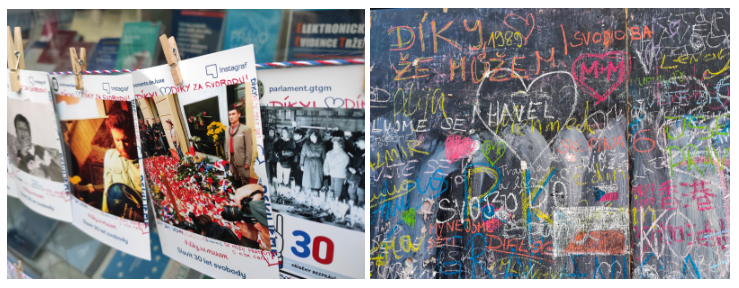
In the evening the National Avenue becomes unbearably full and it is impossible to move. Sára, a theatre performance student, feels anxious in the crowd. “I can’t breathe, I can’t move. I am thinking my mom was also suffocating here back in 1989,” she tells me. The buildings start to change colours from blue, to red and white. Sounds of clashes between the communist police and students fill the street. I get a vivid sense of the 17th of November 1989. The shadows of students getting beaten are projected on the walls. “We have bear hands,” echoes from building to building. “If not us, who? If not now, when?” The National Avenue is at a standstill. People turn their heads up. And I can see a tear streaming down the face of a man standing next to me. I too feel emotional.
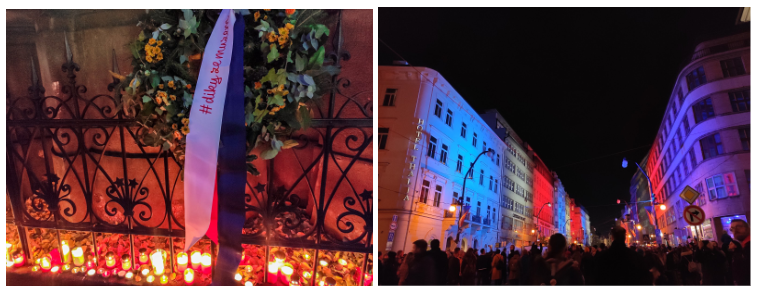
At 17:11 all bells start to ring, candles gently light up the National Avenue and people are rattling their keys. The Velvet Carnival parades across the boulevard: its butchers offer to slaughter the Lion – the symbol of the Czech state. On the menu the butchers have crackling from the independent justice system or a head cheese made from the public media. Maybe I should have purchased the social chewing gum instead. It seems Czechs have been busy laughing, gardening and drinking beer, while the government has been shifting the focus to Russia and China. And Prague stayed cosily wrapped up in its own social bubble. I wonder if the salami democracy has replaced the salami communism of the 1980s. The celebration is a wonderful spectacle, but I can’t escape the feeling tomorrow morning everyone will wake up back into their daily lives of conformity. Věra Kamenická, born in Czechoslovakia before WW2, mentions people have started measuring everything with money: “From an economical perspective, we’ve progressed. But our relationships and spirituality were left behind. What Havel imagined has not happened.”
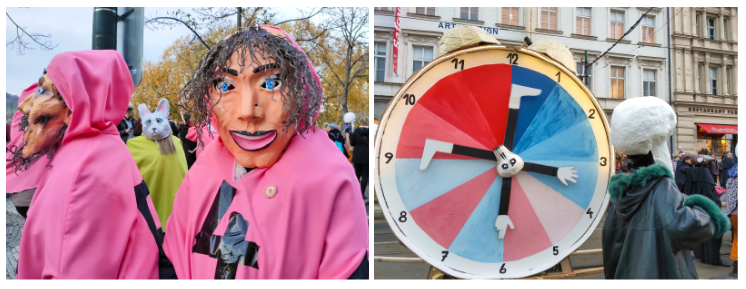
I leave Prague feeling as divided as the city itself. Although the revolution changed the regime, the latest development in politics have sent the country back towards East. But during the anniversary weekend I also witnessed hope. One day Prague’s liberalism and western orientation might not be a rare anomaly in the statistics.
